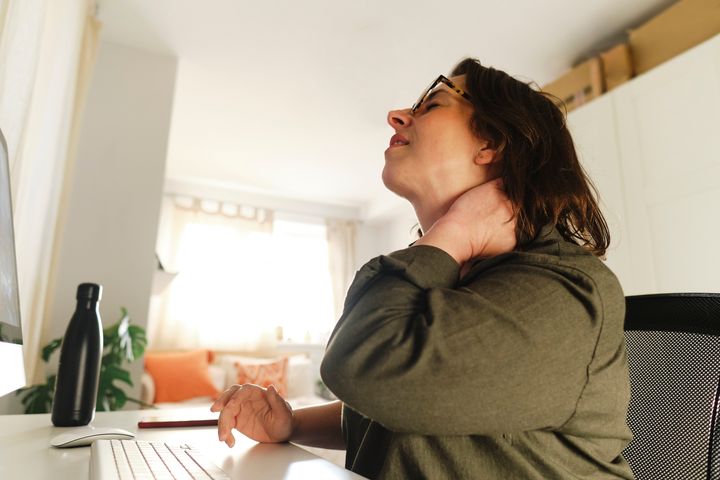Massage guns have surged in popularity in recent years, and for good reason: They actually work. According to a 2023 systematic review, massage guns can help improve short-term range of motion, flexibility and recovery.
This likely comes as good news to anyone who deals with a lot of muscle stiffness. “I used to think they were just gimmicky things that might feel good in the moment but were not that useful,” admitted physical therapist Ingrid Anderson, founder of Intown Physical Therapy in Atlanta, Georgia. “Now, I believe they have a place for pain relief and treating certain conditions.”
But before you whip out that massage gun, are there any parts of the body where a massage gun will do more harm than good? The answer is yes.
You should avoid using a massage gun on your neck.
If you’re one of the 30-50% of adults in the U.S. who suffer from chronic neck pain, please don’t use your massage gun regularly to remedy it.
According to Anderson, you’ll want to stay away from any bony area of your body when using the machine ― and your neck is very bony. If you use it on areas with lots of muscles, like your shoulders or the back part of your neck, that’s a safer bet.
“I don’t recommend using a massage gun on your neck,” she said. “While necks have lots of muscles, there are many superficial bony prominences and superficial nerves, neither of which like being pounded with a massage gun.”
The neck is composed of sensitive areas and vital blood flow that connect to the brain, making using a massage gun on it a not-so-great idea, said Kevin Lees, a chiropractor in Arizona.
“Some areas of muscle have receptors that help with balance. If these receptors are overstimulated or damaged, they can cause nausea and dizziness,” he said. “Pressure from a massage gun may cause soft tissue damage and possibly vascular damage.”
Perhaps you’ve also seen the viral TikTok where one user warned viewers about the dangers of using the tool on your neck after she experienced problems herself. As Health reported, putting the tool on your neck ― which helps with blood flow to the brain ― may also lead to rare but serious injury if you’re not careful.
Ryan Krzyzanowicz, a clinical associate professor and program director of the Master of Science in Athletic Training program at the University at Buffalo School of Public Health and Health Professions, told the outlet that “you do not want to use percussive therapy (a massage gun) over an artery.”
“In the neck we get worried with blood flow to the brain, and in theory, percussion could temporarily starve the brain from blood flow, causing mini-stroke or stroke-like symptoms,” Krzyzanowicz continued. Again, this is more rare, but still a risk to consider.
If your neck is really bothering you, turn to the pros.
“If you are experiencing neck pain, it’s best to see your doctor to determine the underlying cause. If massage is the solution, have a professional work on the affected muscles,” Lees told HuffPost.

Alleviate your neck pain using other, expert-approved methods.
Neck pain is a pain in the neck (sorry, we had to), and it’s clear that a massage gun isn’t the solution. So what is? First, get to the source of the neck pain.
“Neck pain can be caused by a variety of things. Some of the most common are poor posture, stress and poor sleeping positions,” Lees said. “While a massage gun may help with some of the symptoms, addressing the underlying condition is the only way to prevent the problem from recurring. Poor posture can be due to the ergonomics of a workstation, or a muscle imbalance that causes hunching of the upper back. Sleeping awkwardly with an improper pillow or stomach sleeping may also cause neck pain.”
The best way to relieve neck pain, Anderson said, is to stop doing the things that cause it.
“This includes a good work-station setup, not craning your neck forward while working, and, most importantly, lots of breaks. Data show that a 20-second movement break every 20 minutes goes a long way towards preventing neck pain,” she said.
Once you have a stiff and sore neck, Anderson added, the best things you can do at home are heat or cold (whichever feels good!), topical pain relievers such as lidocaine patches or pain-relieving creams and movement.
“Even if it doesn’t feel the best, moving through neck range of motion ― looking right, left, up and down ― goes a long way to shortening an episode of neck pain,” Anderson said.
If your pain doesn’t resolve, chat with your doctor or a physical therapist. You may need some manual interventions like medication, specific exercises or trigger point shots (or all of the above) to help relieve the pain.
There are specific body parts that can benefit from a massage gun.
“Massage guns are best used on large muscles, especially in the legs, shoulders, and back,” Lees said. “These muscles tend to do most of the work when exercising or doing physical labor. Because they are large it’s generally safe to work them with a massage gun unless a tear is suspected.”
Anderson also pointed this out. “Areas of big muscles are the best for massage guns,” she said. “My favourites are quads, calves and glutes. Just make sure and stay away from anything bony, even if it feels useful.”
Long story short: Massage guns can be great, but not for your neck. So if you’re dealing with chronic neck pain, instead of applying a massage gun to that sensitive area, get in to see a professional ASAP.
